Age-related macular degeneration (AMD) is a leading cause of vision loss among seniors, affecting millions of individuals worldwide. This degenerative eye condition targets the macula, the central area of the retina responsible for sharp, central vision. With AMD, daily activities such as reading, driving, and recognizing faces can become increasingly difficult. Understanding the types, symptoms, and advanced treatment options available for AMD is essential in minimizing vision loss and maintaining eye health.
At Valley Laser Eye Centre in Abbotsford, BC, our dedicated team of eye care professionals is committed to providing comprehensive information, exceptional care, and state-of-the-art treatment options to support our patients in managing AMD. In this informative blog post, we will delve into the types and symptoms of AMD, discuss the importance of early diagnosis, and provide an in-depth look at the innovative treatment options available at our clinic.
Distinguishing Between the Two Types of Age-Related Macular Degeneration
There are two primary forms of age-related macular degeneration, each with distinct characteristics and progression patterns:
- Dry AMD: Dry AMD, also known as non-neovascular AMD, accounts for approximately 80-90% of all AMD cases. It develops gradually as yellowish deposits called drusen accumulate beneath the retina. Over time, the drusen may increase in size and number, leading to thinning and deterioration of the macula, eventually causing vision loss.
- Wet AMD: Wet AMD, or neovascular AMD, is characterized by the growth of abnormal blood vessels beneath the retina, referred to as choroidal neovascularization. These fragile vessels can leak fluid and blood into the macula, ultimately causing scarring and rapid vision loss. While wet AMD is less common than dry AMD, it tends to result in more severe vision loss.
Identifying the Symptoms of Age-Related Macular Degeneration
Symptoms of AMD may initially be subtle and become more pronounced as the condition progresses. Some common symptoms include:
- Blurred or distorted central vision
- Difficulty adapting to low light levels
- A gradual decrease in the brightness of colours
- Straight lines appearing wavy or distorted
- The presence of a blurry or dark area in the centre of the visual field
Should you notice any of these symptoms, it is essential to schedule an eye examination with a certified eye care professional to ensure proper diagnosis and treatment.
The Importance of Early Diagnosis for Age-Related Macular Degeneration
Early diagnosis and comprehensive eye examinations are crucial for individuals at risk of AMD. Regular examinations can aid in detecting subtle vision changes, allowing for timely intervention and appropriate management of the condition. At Valley Laser Eye Centre, our comprehensive eye exams include:
- Visual Acuity Test: This test assesses an individual’s visual acuity at various distances using a standardized eye chart.
- Dilated Eye Exam: Dilating the pupil with eye drops allows for a more thorough examination of the retina and macula.
- Optical Coherence Tomography (OCT): This non-invasive imaging technology captures detailed cross-sectional images of the retina, providing valuable information about its structure and potential AMD-related changes.
Early diagnosis can help minimize vision loss due to AMD and enable patients to take proactive steps to maintain their eye health.
Advanced Treatment Options for Age-Related Macular Degeneration at Valley Laser Eye Centre
While there is currently no cure for AMD, several advanced treatment options can help slow its progression and manage its impact on vision. Valley Laser Eye Centre offers the following treatments for AMD:
- Nutritional Supplements: For dry AMD, certain nutritional supplements containing antioxidants and zinc have been shown to help slow disease progression in some individuals. Reporting and discussing changes in vision with an eye care professional will help determine the appropriate course of action.
- Anti-VEGF Injections: In wet AMD cases, intravitreal injections of anti-vascular endothelial growth factor (Anti-VEGF) agents can be highly effective in slowing vision loss. These medications work by inhibiting the growth of abnormal blood vessels and preventing leakage, helping to improve visual acuity.
- Photodynamic Therapy: This treatment option involves the injection of a light-sensitive drug into the bloodstream, which is then activated by a specific wavelength of light applied to the retina. The activated drug damages the abnormal blood vessels without harming the surrounding retinal tissue, preserving central vision.
- Laser Photocoagulation: For some cases of wet AMD, laser treatment can help seal abnormal blood vessels to minimize leakage and prevent further vision loss. However, this treatment may result in a small scotoma (blind spot) in the visual field due to the laser’s heat.
Our skilled eye care professionals will assess your individual needs and help you choose the most suitable treatment option for your version of AMD.
Conclusion
Age-related macular degeneration is a leading cause of vision loss among seniors. By understanding the types, symptoms, and available treatment options, individuals can take proactive steps to minimize vision impairment and maintain eye health. At Valley Laser Eye Centre in Abbotsford, BC, our expert eye care professionals are dedicated to providing personalized care, comprehensive eye examinations, and advanced treatment options for age-related macular degeneration.
Schedule a consultation with our ophthalmologist in Abbotsford to discuss your concerns and explore the most suitable treatment options for AMD. The professionals at Valley Laser Eye Centre are here to support your journey towards optimal visual health and well-being.
Disclaimer: This blog post does not replace medical advice and should not be implemented prior to consulting a fully certified medical professional.





